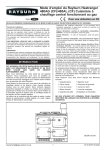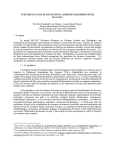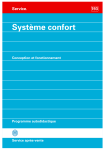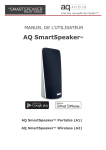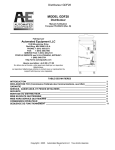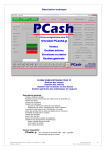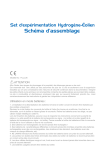Download YORKVILLE Audiopro 3000 Specifications
Transcript
OWNERS MANUAL / GUIDE D' OPERATION INTRODUCTION Your new Yorkville Audiopro 3000 power amplifier is designed and built to provide years of trouble free performance. We believe it to be the best high power amplifier you can buy at any price. Up to now, owning a high power, high efficiency amplifier meant that you had to sacrifice sonic quality. With Yorkville’s 3000 design, we have overcome this problem. The 3000 weighs a comfortable but solid 40 pounds, fits into two rack spaces, runs at near digital efficiency, reproduces music with over 4000 Watts of headroom, draws all the power it needs from a standard AC outlet, and has excellent distortion and noise specifications. It will drive reactive, phase shifted loads with no difficulty, and yet it is fully protected from accidental short circuits. Our design goal was to create an amplifier which would do exactly what an amplifier should do: reproduce music with great power, complete reliability, and complete signal fidelity. We think you will agree that the Yorkville 3000 does exactly that. We hope this manual will provide the answers to the questions you may have about the particular characteristics of this amplifier. Page 1 OWNERS MANUAL / GUIDE D' OPERATION ENERGY MANAGEMENT SYSTEM All amplifiers with ratings above 1400 watts rely on the fact that the average power required to reproduce music is considerably below the maximum power the amplifier is capable of providing. Some amplifiers are capable of actually delivering their rated power continuously, but these may consume as much as 50 amperes in doing so. To get around this problem, many high power amplifiers are shipped with either a special high current plug on the line cord or with two line cords. In practice, the user is often forced to find some way to connect these products to standard line outlets. Due to the lower average power required by music, this will sometimes work, but there is the possibility that circuit breakers in the concert hall will trip in the middle of a performance. The AUDIOPRO 3000 is internally capable of delivering its rated power on a continuous basis. However, rather than leaving the question of energy management to chance, the AUDIOPRO 3000 incorporates active energy management circuitry which continuously monitors the actual power consumed from the AC line. Should that exceed an average of 12 amperes over a sustained period, the AUDIOPRO 3000 will reduce its output power and therefore its power consumption accordingly. The reduction required is very small: A drop in output power of 3 dB will reduce the power consumption to below 12 amperes in even the most extreme cases. Under prolonged actual tests with continuous and compressed music driving two ohm speaker loads connected to each channel, the AUDIOPRO 3000 consumed less than 10 amperes on average, and the energy management circuit was never activated. (This performance is due in large measure to the high efficiency of the AUDIOPRO 3000’s output circuitry: Other amplifiers draw considerably more power under identical conditions!) It is nice to know that an AUDIOPRO 3000 will probably never cause a nuisance trip of a breaker. The AUDIOPRO 3000 is a high efficiency amplifier which is capable of delivering a greater percentage of its input power to the speaker load than most other amplifiers. Under actual operating conditions its power conversion efficiency approaches that of digital switching amplifiers. However, digital switching amps are still plagued by poor specifications and cumbersome operating constraints. The AUDIOPRO 3000 provides the superior transient response and low distortion figures associated with the best and most reliable analog designs. INPUTS and SWITCHES The AUDIOPRO 3000 accepts either balanced or unbalanced inputs. Either XLR or PHONE cords may be used. XLR cords are normally used for balanced operation. However, stereo PHONE cords may also be used. Internally, the AUDIOPRO 3000 inputs are simply wired in parallel: The TIP of the channel “A” PHONE input is connected to pin 2 of its XLR input, the RING is connected to pin 3, and the SLEEVE is connected to PIN 1. MONO/STEREO This switch simply connects the inputs of channel “A” directly to the inputs of channel “B”. A signal connected to either channel thus is routed to both amplifiers. Fig,#2- 2 Page 2 OWNERS MANUAL / GUIDE D' OPERATION DAISY CHAINING In large installations it is often necessary to operate many amplifiers in parallel. Several AUDIOPRO 3000 may be paralleled by patching from the unused input jack of the first amp to the second amp’s input, and so on down the line. The original source must drive all of the amplifiers. Eighteen AUDIOPRO 3000 channels would present a load of about 600 Ohms. Any source capable of driving a 600 Ohm line to +15 dBm should be able to drive this load with no problem. For best results, daisy chaining should be done with balanced patch cords. Ground loop hum can be eliminated by lifting the ground straps of all but the first amplifier in the chain. GROUND STRAP Removing the ground strap on the rear panel will decouple chassis ground from circuit ground. Safety (“earth”) ground is still connected to the chassis. We do not recommend lifting the ground strap unless you are experiencing problems with ground loop hum in multiple amplifier setups where lifting the ground straps of all but one amplifier cures the hum problem. Caution: Sometimes hum problems are an indication of improper AC wiring somewhere else in your system. Don’t just doctor the symptom by lifting grounds: Fix the cause by making sure that the proper electrical wiring safety regulations have been adhered to. BRIDGED OPERATION Historically, bridged mode operation was a means of getting high power from medium power amplifiers. The AUDIOPRO 3000 delivers more power from one channel than most other amps deliver when fully bridged. Bridging the AUDIOPRO 3000 will reproduce music with a headroom of about 4500 Watts into a 4 ohm load! We don’t know of any subwoofers that can handle such power. We recommend that you carefully check the ratings of your speaker system against the power specifications listed in this manual before you consider bridging the AUDIOPRO 3000. We have purposefully made it a little difficult to bridge the AUDIOPRO 3000. You need to construct a special crossed-phase balanced cable. If your input cable is a balanced XLR, you will need a stereo phone cable with the ring connection of one end going to the tip of the other end, and the ring of that end going to the tip of the first end. If your input cable is a phone plug, then you need to make an XLR patch cord with pin 2 of one end going to pin 3 of the other, and pin 3 of that end going to pin 2 of the first end. See Fig, #3. Connect the special cable from channel “A” to channel “B”. Connect the input to your AUDIOPRO 3000 to channel “A”. Put the STEREO/MONO switch in STEREO position. Connect your speaker between the two RED binding posts. (The resulting phase polarity is marked on the panel). You MUST set both front panel gain controls to the same position for bridged operation to work properly. Failure to do this will result in premature current limiting and will produce less power than is produced in non bridged mode's. Again a word of CAUTION: Yorkville’s own high power speaker systems have circuit breaker protection built in. Although they may shut down, they are unlikely to be damaged by a bridged AUDIOPRO 3000. However, many other speaker manufacturers make high power cabinets with no protection features whatsoever. Yorkville Sound Page 3 OWNERS MANUAL / GUIDE D' OPERATION LTD. is not responsible for any damage which may result as a consequence of exceeding such a speaker’s power handling capability. In any case, Yorkville’s two year unconditional warranty does not cover any consequential damages to other equipment. Please consider these facts carefully before you choose to run your AUDIOPRO 3000 in bridged mode. SUBSONIC FILTER PROTECT L.E.D. The AUDIOPRO 3000 features a specially designed subsonic filter which effectively transfers the wasted energy from the band below 30 Hz to the band between 35 and 70 Hz. The filter provides an 18 dB/Oct skirt below 40 Hz and a 3.6 dB boost at 50 Hz. This is achieved with a five pole network designed to minimize phase shift down to 40 Hz. We recommend using this filter in conjunction with most subwoofers and with high power full range cabinets. Engaging this filter immediately produces the perception of a better “bottom end”, while excessive and possibly damaging excursions of the speaker cone are restrained. See Fig, #2- 1 The PROTECT LED will glow steadily if the Energy Management System is activated. In the event of a shorted load or a load which is of too low an impedance for the amplifier to handle, (less than 2 ohms), the PROTECT LED will flash alternately on and off at about one second intervals. The sound may come on and off at the same rate. In this case, the fault in the speakers or the speaker cables should be located and remedied. No reset of the AUDIOPRO 3000 is required to restore proper operation. The AUDIOPRO 3000 is fully protected against all possible passive load conditions. It can operate with a “dead” short continuously without damage. The output stage uses a unique triple slope VI limiting scheme which is sophisticated enough to remain inert during transient currents in excess of 100 amperes and phase angles of more than 45 degrees, yet is capable of protecting the output stage from damage due to accidental short circuits and improper loads. (You may have read that current limiting can affect the sound of an amplifier. Our answer to this is that it only gets in the way of the sound if it is not done properly. In the AUDIOPRO 3000, its done right!) DC PROTECTION CLIP L.E.D.'S OTHER DESIGN DETAILS In the unlikely event of the AUDIOPRO 3000 outputs “going DC”, a thyristor circuit will short the output and divert all potentially harmful currents away from your speakers. The CLIP LEDS on the front panel are of the pulse stretching type. Any excursion beyond the dynamic headroom of the amplifier - no matter how short - is trapped and converted into a visible pulse of light. The AUDIOPRO 3000 represents a significant advance in the art and science of analog power amplifier design. It incorporates MOSFETS where they should be used - in the driver stage where their immunity from secondary breakdown lets them reliably drive bi-polar output devices which can present an essentially capacitive load at high frequencies. The unique design of the output stage uses four supply voltages. This greatly reduces internal power dissipation. Rather than switching between the various supply voltages, the AUDIOPRO 3000 smoothly directs its output stage to the appropriate supply. The output is free of the “glitches” that plague other multiple supply Page 4 OWNERS MANUAL / GUIDE D' OPERATION designs. In fact, due to the proprietary design of the power output section, the discontinuities visible on the distortion analysis product are much smaller than those normally associated with crossover distortion in single supply class AB designs. These circuit advances are clearly reflected in the superior specifications of the AUDIOPRO 3000. The AUDIOPRO 3000 may be the first high power amplifier to offer specifications and sonic performance equal to or surpassing ultra low distortion designs such as class-A amplifiers. RELIABILITY APPLICATIONS The AUDIOPRO 3000 is designed and manufactured by Yorkville Sound LTD. Each unit undergoes a thorough, temperature cycled burn-in period, and each circuit is tested by both manual and sophisticated computer controlled equipment which is capable of identifying any deviation from the design center parameters. The design of the AUDIOPRO 3000 is radical in concept but conservative with respect to the power handling capabilities of the output devices. The topology guarantees that thermal stress - not secondary breakdown - will set the limits of operation, while the computer optimized heat dissipation system insures that excessive thermal stress will not occur. Yorkville’s reputation as a manufacturer of reliable equipment will be further enhanced by the AUDIOPRO 3000. The AUDIOPRO 3000 was designed primarily for high power applications. It excels at driving big systems and subwoofers to their maximum SPL, and its rugged, roadworthy construction ensures that it will keep on doing just that - from location to location for years to come. The AUDIOPRO 3000 is not only suitable for use in both heavy duty touring sound reinforcement systems but also when high headroom and ultra-low distortion are needed to fully reproduce the dynamic range and clarity of today’s CD recordings. This last point needs emphasis: The AUDIOPRO 3000 will drive 8 Ohm loads with better sonic purity and lower distortion than any “listening amplifier” we know of, including those that cost much much more. And, since the AUDIOPRO 3000 is built to survive grueling road conditions and constant 2 ohm operation, its reliability in a fixed installation running 4 or 8 ohm studio monitors is without parallel. Of course, what really counts is how it sounds. Listeners have commented that the AUDIOPRO 3000 provides the clearest most transparent reproduction they have ever heard. You will have to judge for yourself. Page 5 OWNERS MANUAL / GUIDE D' OPERATION SPECIFICATIONS POWER: All values are in WATTS at 1KHz, except FTC 20Hz-20KHz. Measurements made with regulated 120 VAC sine wave at line cord. All values are rounded down to the nearest 25 watts. BURST AVG. Measured as a 2 cycle burst at 1KHz, 8:1 duty. (Continuous measurements may require line currents >15 Amps) ONE CHANNEL DRIVEN (WATTS) LOAD CONT, AVG,. 8 ohms 550 4 ohms 900 2 ohms 1500 BURST AVG 650 1250 2250 PEAK INSTANT 1500 3000 6000 FTC 20-20KHz 475 800 1200 BOTH CHANNELS DRIVEN (WATTS) LOAD 8 ohms 4 ohms 2 ohms CONT, AVG,. 475 750 1200 BURST AVG 625 1200 2175 PEAK INSTANT 1500 3000 6000 FTC 20-20KHz 425 650 950 PEAK INSTANT 3000 6000 12000 FTC 20-20KHz 850 1300 1900 BRIDGED (WATTS) LOAD CONT, AVG,. 16 ohms 925 8 ohm 1500 4 ohms 2400 BURST AVG 1225 2400 4350 THD DISTORTION: ( measured at 1 dB below rated power, BW = 80 KHz ) LOAD 8 ohms 4 ohms 2 ohms AT 1 KHz < 0.003 % < 0.004 % < 0.008 % 20 Hz - 20 KHz < 0.04 % < 0.05 % < 0.06 % CROSS TALK: -75 dB below full power at 1KHz, -60 dB below full power, 20 Hz - 20 KHz. INPUT IMPEDANCE: 20K ohms balanced, 10 Kohms unbalanced. INPUT SENSITIVITY: 1.4 VRMS sine wave = full power. ( 36 dB gain ) CMRR (bal input): >31 dB 20 Hz - 20 KHz CONTROLS: Rotary gain, MONO sw, special subsonic filter sw. DISPLAYS: 2x CLIP, 2x ACTIVITY, PROTECT, POWER ON. (LEDS) FREQUENCY RESPONSE Within 1dB, 20 Hz to 20 KHz, (50 Hz boost sw out) Page 6 OWNERS MANUAL / GUIDE D' OPERATION HUM AND NOISE: -105 dB below max output RMS voltage, unweighted. DC OFFSET: Less than 25 millivolts. PROTECTION: Fully protected: DC, LOAD and THERMAL. COOLING: Interleaved heatsink with DC servo controlled fan. SLEW RATE: Power amp: 30 V/usec, 60 V/usec in bridged mode. (rise time limited to 18 V/usec by input filter). DAMPING FACTOR: > 500, 20 Hz - 400 Hz, into 8 ohms. MAX OUTPUT CURRENT: ` 100 amperes for 10 milliseconds, 50 amperes contin. TURN ON/OFF: < 15 milliwatt / seconds, 0.5 Wpk. (1s on delay) EFFICIENCY: Better than 75% at full power into 4 Ohms. WEIGHT: 40 pounds. 17.75 Kilograms. SIZE: 3.5" x 19" x 15.75 (front panel to binding posts) POWER SUPPLY: Toroidal transformer, 82,000 uF filter caps, combination power switch/circuit breaker. POWER CONSUMPTION: Will not exceed 13.5 Amps under actual conditions. Page 7 OWNERS MANUAL / GUIDE D' OPERATION TROUBLE SHOOTING GUIDE SYMPTOM POSSIBLE CAUSE PROBABLE SOLUTION Power/breaker switch is on, but power LED is off No AC power Connect AC power cord to a live AC receptacle CAUTION: Do not remove chassis cover as there are no replaceable fuses contained inside No music through speakers No music at amplifier’s input. Volume controls turned down. Damaged speaker. Faulty speaker cable. To verify that the music is getting through the amplifier: connect music to the amplifier’s inputs, turn the volume controls up, verify that activity LEDS are flickering. Check speakers, and cables. The music at channel ‘A’s input is heard on channel ‘B’s output or vise versa. The amplifier is in mono mode. Put mono/stereo switch in stereo position (out) Protect LED flashes on and off If music is present at the amplifier’s inputs and the activity LEDS flash in step with the protect led, a short or load less than 2 ohms is present on the corresponding output. If multiple speaker cabinets are connected to the amplifier’s output, disconnect them one by one until the protect LED turns off. If the problem persists with no signal on the input and no speakers are connected, have the amplifier serviced by authorized personal. Protect LED is continuously on. Fan is on high speed. The Energy Management System is correcting for excessive current draw through the AC line cord. The amplifier is automatically turning down the music so that the circuit breaker does not trip. No action needs to be taken. This is a rare but normal condition. Protect LED is continuously on. Fan is on high speed. There’s no sound on the outputs. The amplifier has overheated. Remove any obstruction from the ventilation holes. Amplifier will reset after cooling. Page 8 OWNERS MANUAL / GUIDE D' OPERATION INTRODUCTION Votre nouvel amplificateur de puissance AUDIOPRO AP-3000 a été conçu et fabriqué pour vous servir avec fiabilité pour bien des années a venir. Nous croyons que le AP3000 est le meilleur amplificateur de puissance que vous pouvez acheter à n’importe quel prix. Jusqu’à maintenant, on devait sacrifier la qualité sonore pour posséder un amplificateur de haute puissance parce que ce type d’amplificateur a normalement un plus haut taux de distortion qu’un amplificateur de puissance moins élevée. Nous avons résolus ce problème avec la conception du AP-3000 de Yorkville. Le AP-3000 a un poids confortable, mais solide de 35 livres, s’installe dans 2 “espaces rack”, fonctionne avec une efficacité que se rapproche des conception numérique, reproduit la musique avec au-delà de 4000 watts d’extention dynamique, tire toute la puissance requise d’une prise CA standard et possède d’excellentes spécifications pour le bruit et la distortion. Il peut conduire une charge réactive et déphasée sans difficulté, toute en restant pleinement protegé contre les court-circuits accidentels. Notre bût était de conçevoir un amplificateur qui ferait exactement ce qu’un amplificateur devrait faire: reproduire la musique avec puissance et fidelité tout en étant extrêmement fiable. Nous sommes confiant que vous serez d’accord que c’est exactement ce que le AP-3000 fait. Nous espérons que ce manuel répondera aux questions que vous pourriez avoir à propos des caractéristiques particulières du AP-3000. Page 9 OWNERS MANUAL / GUIDE D' OPERATION SYSTEME DE GESTION ENERGETIQUE La discussion qui suit implique une opération avec 120 VCA 60 Hz. Tous les amplificateurs qui ont une puissance nominale au-dessus de 1400 watts comptent sur le fait que la puissance moyenne requise pour reproduire la musique est considérablement en-dessous de la puissance maximum que l’amplificateur est capable de fournir. Quelques-uns de ces amplificateurs peuvent vraiment, de façon continue, fournir leur puissance nominale, mais en opérant ainsi, ils peuvent consommer jusqu’a 50 ampères. Pour contourner ce problème, plusieurs amplificateurs sont expédiés avec soit une prise spéciale pour courant élevé sur le cordon d’alimentation, soit deux cordons d’alimentation. En pratique, l’utilisateur est souvent forcé de trouver une façon de brancher ces appareils à une prise de courant standard. Parce que la musique requiert normalement une puissance moyenne moins élevée, cela peut parfois fonctionner, mais il y a alors une possibilité que le circuit disjoncteur de la salle de concert déclanche. Le AP-3000 est internalement capable de fournir sa puissance nominale sur une base continue. Toutefois, au lieu de laisser la question de gestion énergétique au hazard, le AP-3000 possède un circuit actif de gestion énergétique qui vérifie constament la consommation de puissance à partir du cordon d’alimentation CA. Si cette consommation excède douze ampères sur une période de temps soutenue, le AP-3000 réduit automatiquement sa puissance de sortie pour ainsi réduire sa consommation de puissance. La réduction requise est très petite: une chutte de 3 dB à la sortie va réduire la consommation de puissance en-dessous de 12 ampères même dans les cas extrêmes. Sous des tests prolongés, avec de la musique continue et compressée et un haut-parleur de 2 ohm branché a chaque sorties, le AP-3000 a consommé en moyenne moin de 10 ampères et le systeme de gestion énergétique n’a jamais été déclanché. On attribue cette performance en grande partie a la haute éfficacité du circuit de sortie du AP-3000: Dans les même conditions, les autres amplificateurs consomme beaucoup plus de puissance. Il est rassurant de savoir que le AP-3000 ne déclanchera probablement jamais un disjoncteur de courant. La haute éfficacité du AP-3000 lui permet de livrer a sa sortie un plus haut pourcentage de la puissance présente a l’entrée que la pluspart des amplificateurs. Sous des conditions d’opération réelles, son éfficacité a convertir la puissance se rapproche de celle des amplificateur a commutateur numérique. Toutefois, les amplificateurs à commutateur numérique demeurent tourmentés par des spécifications médiocres et une opération restrainte encombrante. Le AP-3000 fournit une meilleur réponse des transitoires et des figures de distortion basse associées avec les meilleurs et les plus robuste amplificateur analogue. ENTREES ET COMMUTATEURS Le AP-3000 accepte des entrées symétrique et assymétrique. Les prises 1/4" ou XLR peuvent êtres utilisé. Les fils avec prise XLR sont normalement utilisés pour une opération symétrique, toutefois les prise 1/4" stéréo peuvent aussi être utilisées. Les entrées du AP-3000 sont internallement branchées en parallèle: la pointe de la prise d’entrée 1/4 du canal A est branché a la tige 2 de la prise XLR correspondante.La couronne est branché at la tige 3, et le manchon a la tige 1. Page 10 OWNERS MANUAL / GUIDE D' OPERATION MONO / STEREO Ce commutateur raccorde simplement l’entrée du canal “A” a l’entrée du canal “B”. Le signale branché a l’un ou l’autre des entrées s’achemine donc vers les 2 amplificateurs. MONATGE EN CHAINE Pour de larges opérations, il est souvent nécessaire d’utiliser plusieurs amplificateurs en parallèle. Plusieurs AP-3000 peuvent êtres raccordés en parallèle à partir des prises d’entrée.Brancher simplement la prise d’entrée qui n’est pas utilisée du premier AP3000 à la prise d’entrée du second et ainsi de suite. La source originale doit entrainer tous les autres. Dix-huit AP-3000 représente une charge d’environ 600 ohms. N’importe quelle source capable de livrer + 15 dB a 600 ohms devrait être capable de piloter cette charge sans problème. Pour de meilleur résultat lors des montage en chaine, utilisez des fils symétriques. On peut éliminer le bourdonnement associé au boucle de masse en déconnectant les tresses de mise à la terre sur tous les amplificateurs excepté le premier. TRESSE DE MISE A LA TERRE Débrancher la tresse de mise a la terre sur le panneau arriere de AP-3000 découple la masse entre le châssis et le circuit. La mise à la terre de sûreté demeure toutefois branche au châssis. A moins que vous n’ayez des problemes de bourdonnement due a la boucle de masse nous vous recommandons de laisser la tresse de mise a la terre branchée. ATTENTION: Les problèmes de bourdonnement indiquent parfois un mauvais câblage AC dans votre système. Ne réglé pas ces problèmes en levant simplement les tresses de mises à la terre: assurez-vous que votre câblage électrique est en accord avec les normes de sécurité. OPERATION EN PONT Historiquement, opérer un amplificateur en pont était un moyen d’obtenir plus de puissance à partir d’un amplificateur de puissance moyenne. Le AP-3000 livre plus de puissance sur un canal que la pluspart des amplificateurs montés en pont. Avec un charge de 4 ohms, en pont, le AP-3000 peut reproduire la musique avec une extention dynamique de 4500 watts! A notre connaissance, aucun haut-parleur de basse ne peut soutenir autant de puissance, nous vous recommandons donc de verifier la puissance nominal de vos haut-parleur et de la comparer avec les specifications incluses dans ce manuel. Nous avons consciencieusement rendue le raccordement en pont du AP-3000 difficile. Vous devez fabriqué un fil équilibré à phase croisée spéciale. Si vous utilisez un fil XLR symétrique à l’entrée, vous avez besoin d’un fil stéréo avec fiche 1/4" stéréo configuré comme ceci: l’anneau a un bout du fil, doit être branchée à la pointe de l’autre bout et la pointe à l’anneau. Si vous utilisé à l’entrée un fil avec prise 1/4" , vous aurez besoin d’un fil XLR configuré comme ceci: la tige 2 à un bout du fil doit être branchée à la tige 3 à l’autre bout et la tige 3 à la tige 2. Brancher ce fil spéciale du canal “A”au canal “B” de votre AP-3000, et injecté le signal d’entré au canal “A”. Placé le commtateur STEREO/MONO à la position ‘STEREO’ et brancher votre haut-partleur au 2 bornes de raccordement rouges. (La polarité de phase qui en résulte est inscrite sur le panneau.) Page 11 OWNERS MANUAL / GUIDE D' OPERATION Pour que l'opération en pont fonctionne correctement, vous devez régler les deux contrôles de gain à la même position, faute de quoi, le courant sera limité prémateurément et la puissance de sortie sera moins grande qui si l'amplificateur était utilisé en mode régulier. ATTENTION: Un disjoncteur de protection est encastré dans les systemes de hautparleurs haute puissance de Yorkville. Quoiqu’ils peuvent cessé temporairement de fonctionner, il est peu probable qu’ils soient endommager par un AP-3000 opéré en pont. Toutefois, plusieur fabriquants produisent des cabinets haute puissance sans protection. Yorkville Sound Ltd n’est responsable d’aucun dommage qui pourrait être cause par un excès de puissance appliqué sur des haut-parleurs incapable de la soutenir. La garantie inconditionnelle de 2 ans de Yorkville ne couvre en aucun cas, les dommages conséquent sur les autres équipments. Veuillez S.V.P. considerer attentivement ces fait avant de considerer utiliser votre AP-3000 en mode “montage en pont”. FILTRE SUBSONIQUE Le AP-3000 se distingue avec un filtre subsonique spécialement conçue qui transfert efficacement l’énergie perdue des bandes inférieur a 30 Hz au bandes entre 35 et 70 Hz. Le filtre prévoit une coupure de 18 dB/Oct en-dessous de 40Hz et un renforcement de 3.6 dB à 50 Hz. Tout ceci est réalisé grâce à un réseau à 5 pôles conçue pour minimisé le déphasage en-dessous de 40 Hz. Nous vous recommandons d’utiliser ce filtre en conjonction avec la pluspart des haut-parleurs de grave ainsi qu’avec les cabinets pleine bande de haute puissance. Une meilleur perception des basses fréquences et un protection contre les excursions excessives qui pourrait possiblement endommager les haut-parleurs sont les résultats obtenues suite à l’engagement de ce filtre subsonique. D.E.L PROTECRICE Lorsque le systeme de gestion énergétique est actif, la D.E.L. protectrice reste constamment illuminée. Lorsqu’une charge court-circuitée ou une charge dont l’impédance est inférieur à ce que l’amplificateur peut supporter (moins de 2 ohms) se presente a celui-ci, la D.E.L. protectrice clignote à des intervalles d’environ une seconde. Le son peut être coupé et activé à la même fréquence. Dans ce cas, on doit localiser et réglé le problème qui réside dans les haut-parleurs ou dans le câblage des haut-parleur. Aucun réglage du AP-3000 n’est nécessaire pour restorer le mode d’opération. Le AP-3000 est pleinement protégé contre les charges passive. Il peut opérer sans cause de dommage, une charge court-circuitée continue. L’étage de sortie utilise un arrangement limiteur a triple pentes d’attenuation suffisament sophistiqué pour demeurer neutre durant les transitoires de courant qui excède 100 ampères et les angles de phase de plus de 45° tout en protégeant l’étage de sortie contre les dommages causé par des charges court-circuitées ou des charges trop basses accidentelles. (Vous avez possiblement lu que limiter le courant pourait affecter la qualité sonore d’un amplificateur. Notre réponse à ceci est que cela peut être un obstacle seulement si l’on en fait un usage incorrecte. Le AP-3000 en fait un usage impécable.) Page 12 OWNERS MANUAL / GUIDE D' OPERATION AUTRES DETALIS DE CONCEPTION Les D.E.L. indicatrices d’écrêtage sur le panneau avant sont du type correcteur de forme. N’imorte quelle excursion, aussi petite qu’elle soit, qui dépasse les limites de l’extention dynamique de l’amplificateur, est piégée et convertit en un clignotement lumineux. Le AP-3000 représente un avancement considérable dans l’art et la science de la conception de l’amplificateur analogue. Les transistors à effet de champ sont incorporés à l’étage pilote où leur immunité contre les claquement secondaire leur permet d’entrainer, avec fiabilité, les pièces de sortie bipolaires qui peuvent présenter à haute fréquence, une charge essentiellement capacitive. La conception unique de l’étage de sortie utilise quatre tensions de réseau, ce qui réduit considérablement la dissipation de puissance interne. Plutôt que d’utiliser la commutation entre plusieurs tension de réseau, le AP-3000 dirige sont étage de sortie sur le réseau approprié, ce qui libère la sortie des transitoires qui tourmente les autres conception à multiple alimentations. En fait, due au proprietés de la conception de la section de sortie, les discontinuitées visibles sur l’analyse de distortion sont considérablement plus petites que ceux normallement associés avec la distortion de croisement dans un amplificateur de classe AB à alimentation simple. Les spécifications supérieures du AUDIOPRO 3000 reflète clairement la perfection de ses circuits. Le AP-3000 est probablement le premier amplificateur haute puissance à offir des spécifications et une performance audio équivalente où supérieur à celles des amplificateurs à distortion très basse telle que les amplificateurs “classe A”. FIABLITE Le AUDIOPRO 3000 a été conçu et fabriqué par Yorkville Sound Ltd. Chaque appareil subit une période de rodage minutieuse et chaque circuit est testé manuellement ainsi qu’avec équipment controllé par ordinateur. L’AUDIOPRO 3000 représente un changement de concept radical mais demeure toutefois conservateur par rapport à sa puissance nominale. L’étude des propriétés garantie que la contrainte thermique, et non les claquements sécondaire, déterminera la limite d’opération alors que le système de dissipation de chaleur assure la limitation des contraintes thermiques. La réputation de fabriquant d’appareil fiable de Yorkville ne peut être qu’accrue avec le AP3000. APPLICATIONS Le AUDIOPRO 3000 a été conçu pour les opérations où une haute puissance est requise. Il est excellent pour obtenir des systèmes importants et des haut-parleurs de grave une pression sonore maximum et sa construction robuste vous assure une fiabilité à toute épreuve pour bien des années à venir. Le AUDIOPRO 3000 est non seulement excellent pour les situations qui demandent un grand rendement, mais il excelle aussi à reproduire la clarté des enregistrements sur disque compact où une extention dynamique considérable et un très bas taux de distortion sont nécessaires. Le AUDIOPRO 3000 peut conduire une charge de 8 ohms avec une meilleur qualité sonore et un taux de distortion plus bas que n’importe quel amplificateur d’écoute que nous connaissons. Considérant le fait que le AP-3000 peut Page 13
This document in other languages
- français: YORKVILLE Audiopro 3000

























